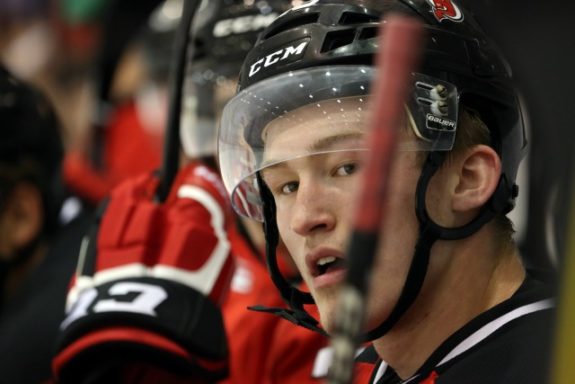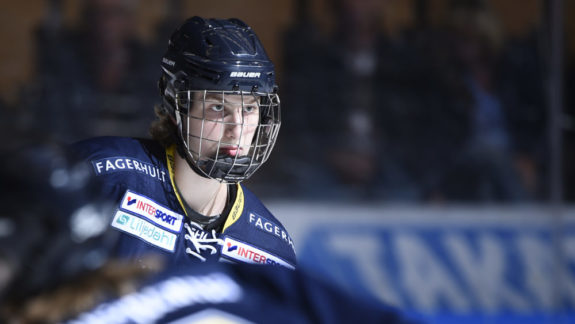Saturday marked the final day of the week-long 2017 World Junior Summer Showcase (WJSS), where top players under the age of 20 from the four biggest hockey nations; the U.S., Canada, Finland, and Sweden, auditioned for a spot on their national team for the 2018 International Ice Hockey Federation (IIHF) World Junior Championship happening in Buffalo this year.
As the level of competition on each national team increases, this year’s competitors featured a lot of new and unique talent. One of the most fascinating aspects of the games being the differing techniques used by defensemen and how their roles have changed in the last few years. Each nation uses their blue liners differently, and perhaps it’s because each nation tends to develop them in different leagues. The results are different styles-of-play and these differences really do stand out when they’re playing against each other.
For example, Adam Fox, a defender with Team USA played in five games during the WJSS this year, scored three goals and six assists with nine shots on net. Fox is very offensive and he’s honing this trait with the NCAA’s Harvard University.
Congrats to Adam Fox, the #ECACHockey Rookie of the Year! pic.twitter.com/Vnqwg4Mh0m
— Harvard Men's Hockey (@HarvardMHockey) March 17, 2017
Although Juuso Välimäki, a first-round pick from the 2017 Draft playing for Team Finland only got one assist in five games, he also got a whopping 18 shots on goal. He was constantly shooting the puck – perhaps a skill he’s been focusing on since playing with the Tri-City Americans two seasons ago.
For Team Sweden, both Timothy Liljegren (2017 first-round pick) and Erik Brännström (2017 first-round pick) played on the backend with impressive offensive prowess. They also played in both the SuperElit league and the Swedish Hockey League (SHL) last season; leagues known for developing that ‘Euro flair’ in guys who eventually make it overseas and create reputations of stylistic moves.
Combating the Offensive Defenseman
Now there’s an added element for NHL general managers to take into consideration when building teams. When they’re scouting, drafting and signing players to entry-level contracts, they need to look at how each player’s role is changing with the evolving game. It’s fair to say that Team Canada was not well prepared for the offensive talents of Fox or Joey Anderson.

So there are two strategies moving forward. The first is to get offensive defensemen like Fox and the second strategy is to get good at combating offensive defensemen like Fox.
When looking at these types of defensemen in the NHL today, we can see that some are tall, some are average in size and an increasing number are under six-feet in height. Often, smaller defenders are paired with bigger, more defensive defensemen. When a team’s entire back end is on the smaller side though, the front end will often make up for the lost size. This is still important because smaller speedsters can’t outskate the bigger players all the time. Size and weight are still used to gain puck possession on every team, regardless of how quick the hands and feet are of their smaller elitists.
How Are the LA Kings Faring?
So when fans are looking at the pool of prospects for the team they support, confidence can be gained and even restored when a clear strategy is evident and that it aligns with the NHL’s changing yet predictable landscape.
When looking at the Los Angeles Kings, for instance, it’s clear they’re preparing a crop of defensemen to be NHL-ready in the next two to four years – the same time it will take for the contracts of all six of their current defenders to end. At this year’s WJSS, the LA Kings had three defensemen representing three nations at the event. Kale Clague, a second-round pick from the 2016 Draft represented Team Canada, Jacob Moverare, a 2016 selection taken in the fourth round represented Team Sweden and Michael Anderson, a 2017 pick also from the fourth round represented Team USA. Over the past week, they each competed against each other but in the next few years, they’ll be competing on the same team.

So the question is, are the Kings evolving their backend enough to stay competitive in an evolving league or are they sticking to the same blue print that got them two Stanley Cups back in 2012 and 2014?
Logic says that if it worked before then it will work again but it also says that times have changed and adapting is inevitable. Well, the Kings are sticking to what they know best – big boys who put defense first but they’re also changing their preferences on where their backend develops before they come to California.
We know that players from the NCAA are entering the NHL in huge waves lately but what’s not so well-known is that there are more NCAA-developed defensemen having success at the NHL-level than any other position. Regardless of why this is, teams of the NCAA are becoming ideal places for defensemen to develop and perhaps that has something to do with 50 percent of the defensemen invitees at the Kings’ 2017 Development Camp already playing on a NCAA team or are committed to one for the 2017-18 season.
Michael Anderson: 2017 LA Kings Draft Pick
Michael Anderson was one of those camp invites and he intends to play for the University of Minnesota-Duluth next year, alongside his older brother, Joey Anderson, who also attended the 2017 WJSS and got a hat trick against Team Canada in their final game on Saturday night.
When asked about being drafted by the Kings and knowing if it would be them who selected him, this is what Anderson had to say:
I figured there was a chance but you know, you can’t know what’s going to happen. Ultimately, they picked me and I don’t think it could have been a better fit. I mean, just the way they play the game, the type of defensemen – and their style. I feel like I am similar to most of the guys they got, so I feel I can find a way into the lineup with the way I play the game… being just you know, a sound defenseman, in position all the time, winning little battles, and you know, just taking pride in playing defense first and pitching in offensively and keeping the main focus on defense. – Mikey Anderson
Anderson is quite similar to most of the guys the LA Kings have and he knows it. “My strength is probably my compete level and my hockey IQ,” he told The Hockey Writers Saturday night after their win against Team Canada. “Those are two things I try to take pride in. I think ultimately, I gotta work on my skating a little bit, get a little bit faster, a little more agile but you know, obviously to get stronger will help with that but I’d say that’s my biggest thing to work on right now”.
There’s a common theme among Kings’ prospects in general and it’s not limited to back-end positions only. The Kings place the most value on high compete levels, quality character and an uncanny obsession for winning puck battles. Another commonality is that more often than not, their skating ability is less than adequate too.
Jacob Moverare: 2016 LA Kings Draft Pick
This is the case with Moverare, who played for the OHL’s Mississauga Steelheads last season. Even before choosing to play in Canada, he wanted to improve his skating and he thinks he’s made progress but still has work to do. “I still got a long way to go but I think I’ve improved,” he said. “We practiced three times a week in the morning (an hour before the team practice) – me and a couple other guys on the team and I think it really helps”. This is when Moverare works on the technical aspects of skating, such as acceleration, speed, and edge work and if he keeps up the extra practice, perhaps he’ll get an invite to the Kings’ development camp next summer.

Of course, the Kings keep tabs on their developing assets whether they attend camp or not. “They come down and watch me – and we have (Spencer) Watson too… so they’ve come down and watched us play a couple times… they come down to the locker room and talk about how the game went and how the season’s going”. Admittedly, there is a common theme in their discussions; “…just keep trying to work on my skating, keep moving my feet, try to move my feet as fast as I can on the ice”.
In Moverare’s final game at the WJSS against Team Finland on Saturday, he didn’t play on any of the power plays. “I played on the power play there (in Mississauga) but there’s so many good power play guys from this team, I didn’t really feel like I needed to play power play,” he said after the game. He did play on the penalty kill though, saying “it’s a little harder but I kinda like it. I kinda want to help the team to not get scored on”. Like Anderson, Moverare seems like a pretty sound defenseman too. He’s confident in his ability to participate on special teams, just as Anderson is with his likeness to the Kings roster.
Like Anderson, Moverare seems like a pretty sound defenseman too. He’s confident in his ability to participate on special teams, just as Anderson is with his likeness to the Kings’ roster. At this point, it’s not clear if the Kings will implement any true offensive weapons on the backend soon but they are, however, collecting a pool of defensive prospects who’re gaining experience in playing against this type of offensive defenseman. For a very long time, they’ve placed a high value on scouting players in the OHL but as of late, they’ve been putting just as many resources on scouting defensemen in or planning to be in the NCAA. This is just one way they’re keeping themselves competitive and staying up-to-date on development trends.
At this point, it’s not clear if the Kings will implement any true offensive weapons on the backend soon but they are, however, collecting a pool of defensive prospects who’re gaining experience in playing against this type of offensive defenseman. For a very long time, they’ve placed a high value on scouting players in the OHL but as of late, they’ve been putting just as many resources on scouting defensemen in or planning to be in the NCAA. This is just one way they’re keeping themselves competitive and staying up-to-date on developmental trends.